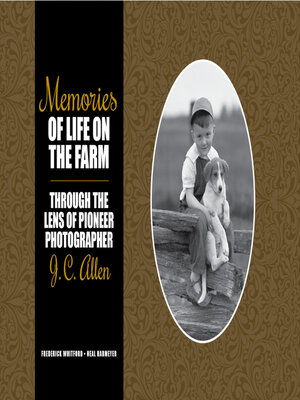Memories of Life on the Farm
ebook ∣ Through the Lens of Pioneer Photographer J. C. Allen · Founders
By Frederick Whitford

Sign up to save your library
With an OverDrive account, you can save your favorite libraries for at-a-glance information about availability. Find out more about OverDrive accounts.
Find this title in Libby, the library reading app by OverDrive.



Search for a digital library with this title
Title found at these libraries:
| Library Name | Distance |
|---|---|
| Loading... |
John Calvin Allen, professionally known as J. C., worked as a
photographer for Purdue University from 1909-1952, and operated his own
photography business until his death in 1976. The J. C. Allen photographs
represent a historical account of the transition from pioneer practices to
scientific methodologies in agriculture and rural communities. During this
major transitional period for agriculture, tractors replaced horses, hybrid
corn supplanted open-pollinated corn, and soybeans changed from a novelty crop
to regular rotation on most farms. During this time, purebred animals with
better genetic pedigrees replaced run-of-the-mill livestock, and systematic disease
prevention in cattle, swine, and poultry took place.
Allen's photographs also document clothing styles, home furnishings, and the items people thought important as they went about their daily lives. Looking closely at tractors, livestock, wagons, planters, sprayers, harvesting equipment, and crops gives one a sense of the changing and fast-paced world of agriculture at that time.
This volume contains over 900 picturesque images, most never-before-seen, of men, women, and children working on the farm, which remain powerful reminders of life in rural America at the turn of the twentieth century. As old farmhouses and barns fall victim to age, Allen photographs are all that remain. While those people and times no longer exist today, they do remain "alive" because of the preservation of that history on film. A camera in his hands and an eye for photography allowed Allen to create indelible visual histories that continue to tell the story of agriculture and rural life from long ago.







